Analysis of Australian National Maritime Museum Tourism in Sydney
VerifiedAdded on 2020/02/23
|11
|2173
|159
Report
AI Summary
This report provides a comprehensive analysis of the Australian National Maritime Museum (ANMM) in Sydney, a major tourist attraction located in Darling Harbour. The report begins with an introduction to the museum, detailing its location, history, and key exhibits. It then presents an analytical report, examining the museum's attributes such as ownership, authenticity, status, accessibility, and market. A SWOT (Strengths, Weaknesses, Opportunities, and Threats) analysis is conducted to assess the museum's position and potential. Finally, the report offers recommendations for enhancing the visitor experience, including interactive programs, improved accessibility, and website enhancements. The report concludes by emphasizing the museum's established position and potential for further growth through strategic improvements.
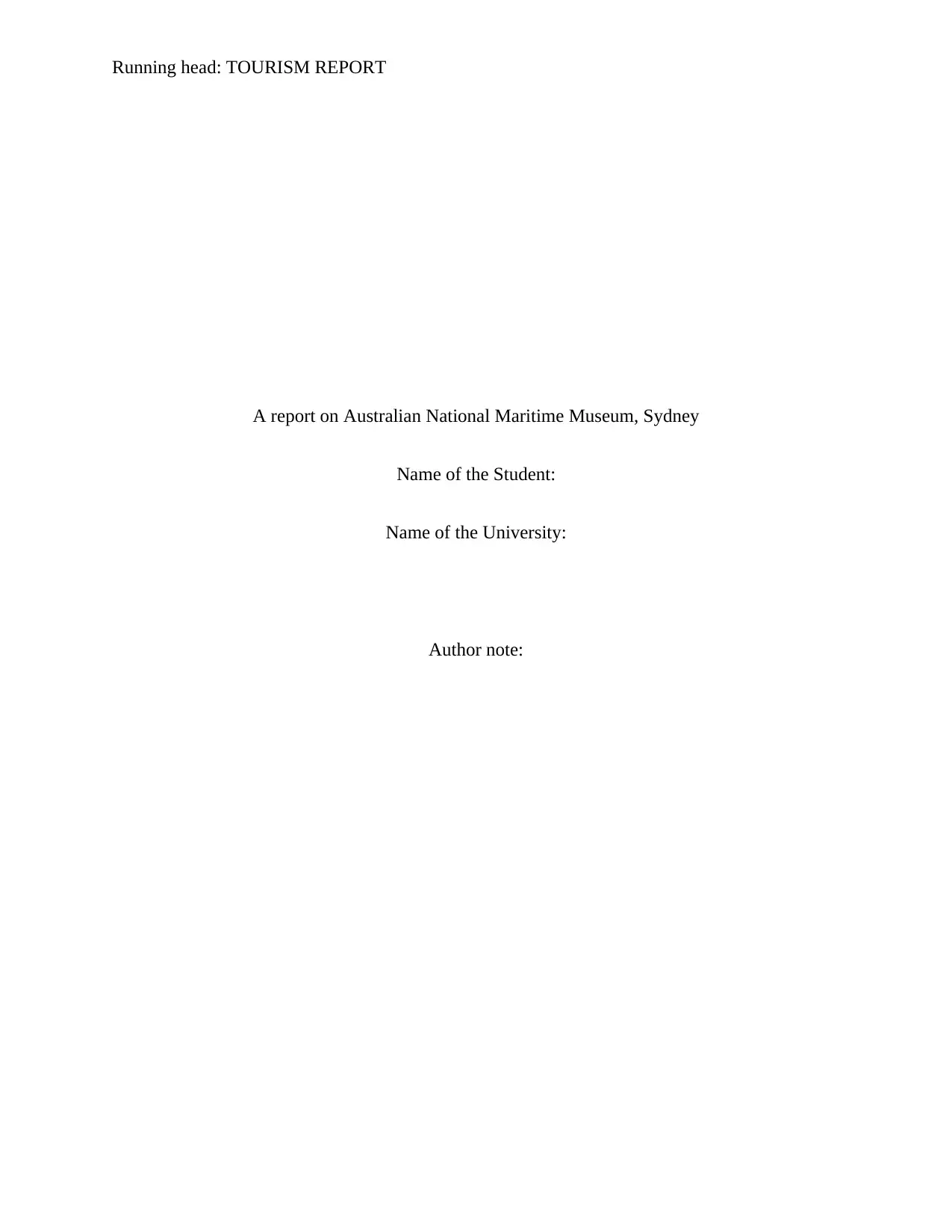
Running head: TOURISM REPORT
A report on Australian National Maritime Museum, Sydney
Name of the Student:
Name of the University:
Author note:
A report on Australian National Maritime Museum, Sydney
Name of the Student:
Name of the University:
Author note:
Paraphrase This Document
Need a fresh take? Get an instant paraphrase of this document with our AI Paraphraser
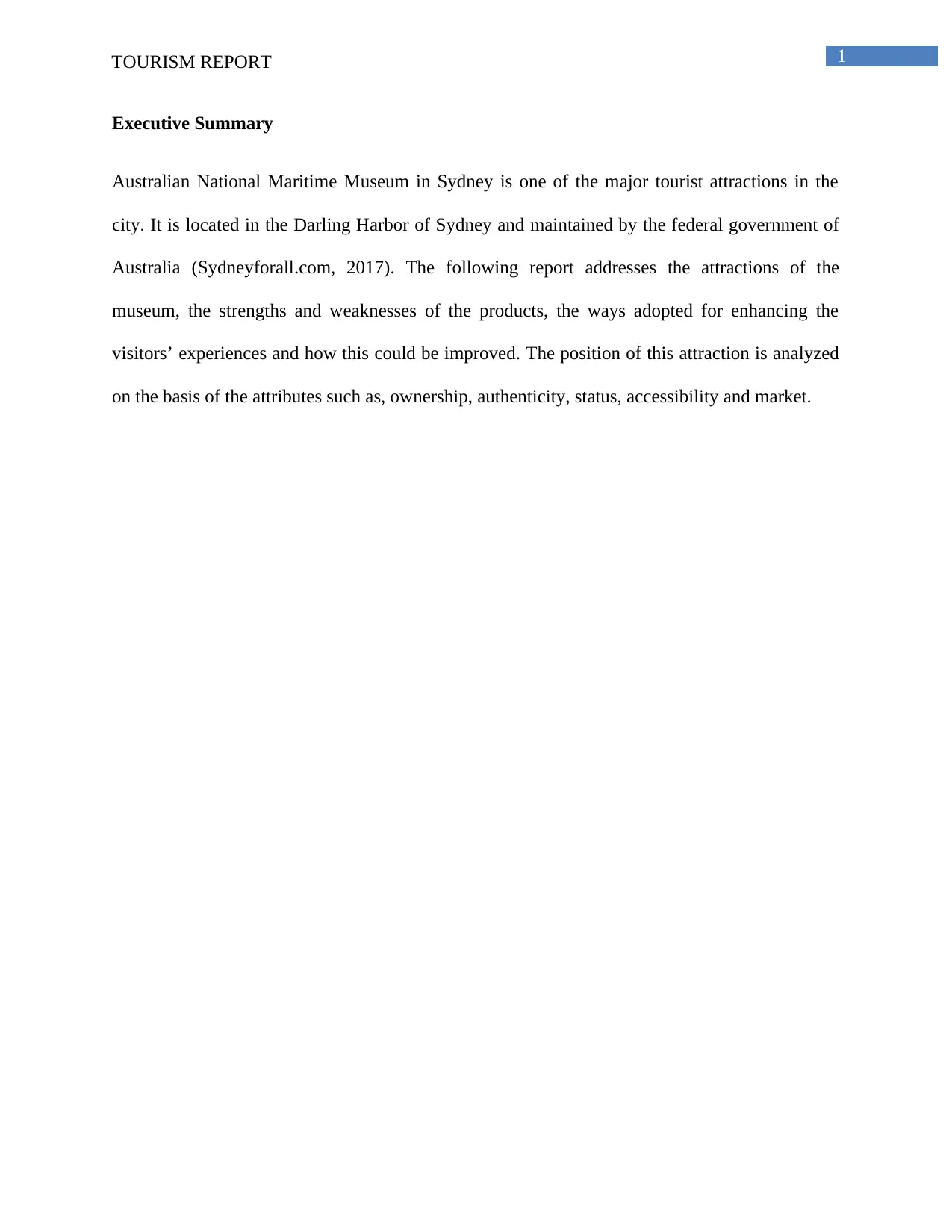
1TOURISM REPORT
Executive Summary
Australian National Maritime Museum in Sydney is one of the major tourist attractions in the
city. It is located in the Darling Harbor of Sydney and maintained by the federal government of
Australia (Sydneyforall.com, 2017). The following report addresses the attractions of the
museum, the strengths and weaknesses of the products, the ways adopted for enhancing the
visitors’ experiences and how this could be improved. The position of this attraction is analyzed
on the basis of the attributes such as, ownership, authenticity, status, accessibility and market.
Executive Summary
Australian National Maritime Museum in Sydney is one of the major tourist attractions in the
city. It is located in the Darling Harbor of Sydney and maintained by the federal government of
Australia (Sydneyforall.com, 2017). The following report addresses the attractions of the
museum, the strengths and weaknesses of the products, the ways adopted for enhancing the
visitors’ experiences and how this could be improved. The position of this attraction is analyzed
on the basis of the attributes such as, ownership, authenticity, status, accessibility and market.
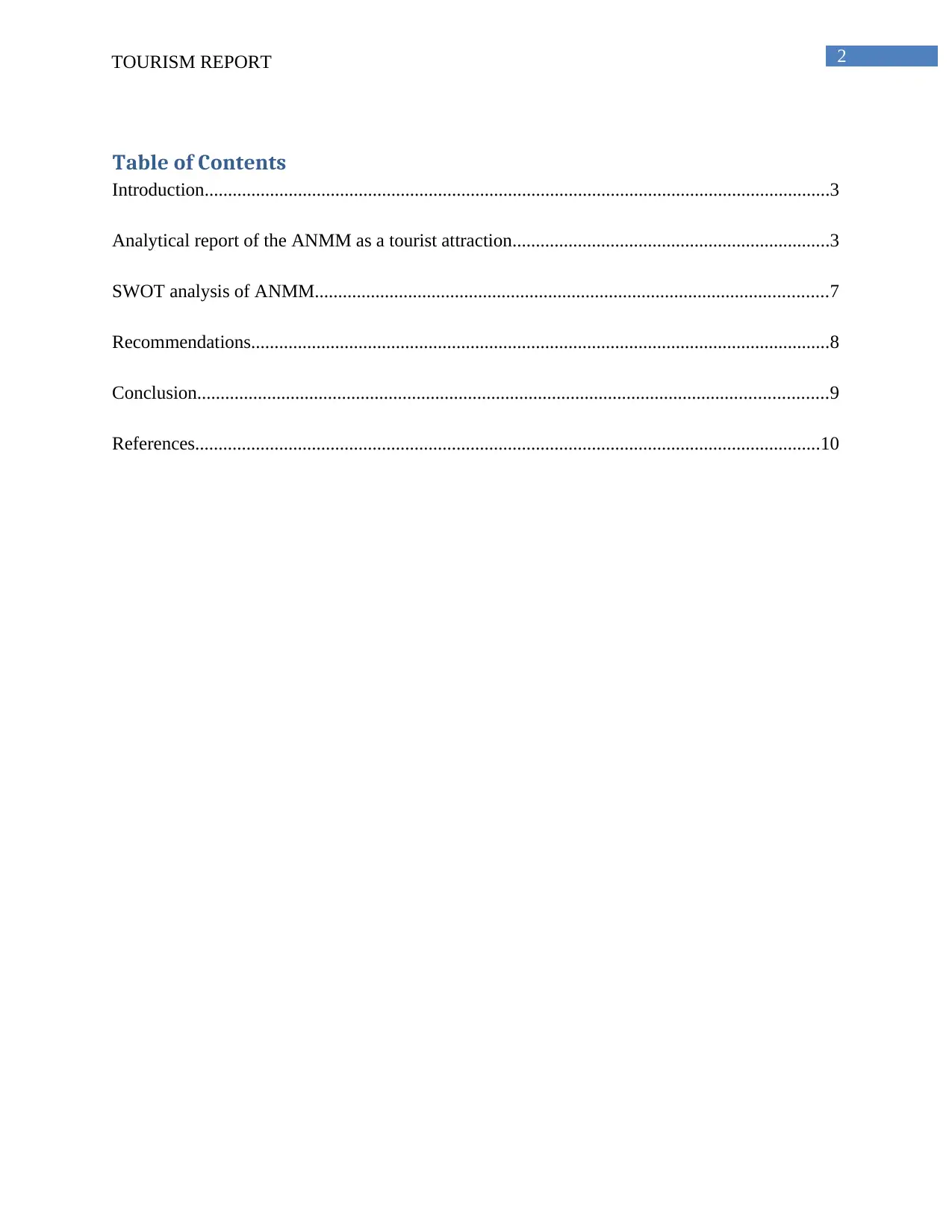
2TOURISM REPORT
Table of Contents
Introduction......................................................................................................................................3
Analytical report of the ANMM as a tourist attraction....................................................................3
SWOT analysis of ANMM..............................................................................................................7
Recommendations............................................................................................................................8
Conclusion.......................................................................................................................................9
References......................................................................................................................................10
Table of Contents
Introduction......................................................................................................................................3
Analytical report of the ANMM as a tourist attraction....................................................................3
SWOT analysis of ANMM..............................................................................................................7
Recommendations............................................................................................................................8
Conclusion.......................................................................................................................................9
References......................................................................................................................................10
⊘ This is a preview!⊘
Do you want full access?
Subscribe today to unlock all pages.

Trusted by 1+ million students worldwide
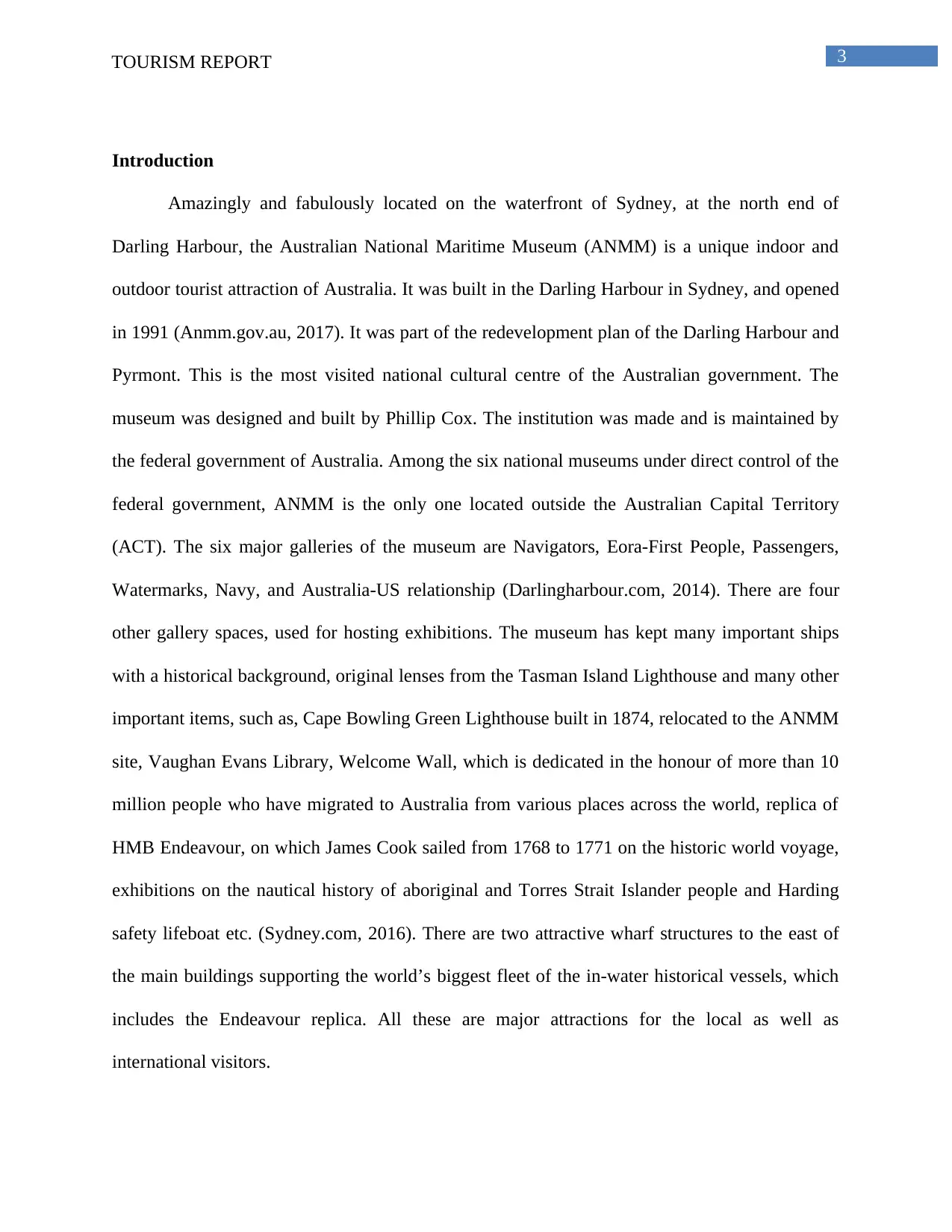
3TOURISM REPORT
Introduction
Amazingly and fabulously located on the waterfront of Sydney, at the north end of
Darling Harbour, the Australian National Maritime Museum (ANMM) is a unique indoor and
outdoor tourist attraction of Australia. It was built in the Darling Harbour in Sydney, and opened
in 1991 (Anmm.gov.au, 2017). It was part of the redevelopment plan of the Darling Harbour and
Pyrmont. This is the most visited national cultural centre of the Australian government. The
museum was designed and built by Phillip Cox. The institution was made and is maintained by
the federal government of Australia. Among the six national museums under direct control of the
federal government, ANMM is the only one located outside the Australian Capital Territory
(ACT). The six major galleries of the museum are Navigators, Eora-First People, Passengers,
Watermarks, Navy, and Australia-US relationship (Darlingharbour.com, 2014). There are four
other gallery spaces, used for hosting exhibitions. The museum has kept many important ships
with a historical background, original lenses from the Tasman Island Lighthouse and many other
important items, such as, Cape Bowling Green Lighthouse built in 1874, relocated to the ANMM
site, Vaughan Evans Library, Welcome Wall, which is dedicated in the honour of more than 10
million people who have migrated to Australia from various places across the world, replica of
HMB Endeavour, on which James Cook sailed from 1768 to 1771 on the historic world voyage,
exhibitions on the nautical history of aboriginal and Torres Strait Islander people and Harding
safety lifeboat etc. (Sydney.com, 2016). There are two attractive wharf structures to the east of
the main buildings supporting the world’s biggest fleet of the in-water historical vessels, which
includes the Endeavour replica. All these are major attractions for the local as well as
international visitors.
Introduction
Amazingly and fabulously located on the waterfront of Sydney, at the north end of
Darling Harbour, the Australian National Maritime Museum (ANMM) is a unique indoor and
outdoor tourist attraction of Australia. It was built in the Darling Harbour in Sydney, and opened
in 1991 (Anmm.gov.au, 2017). It was part of the redevelopment plan of the Darling Harbour and
Pyrmont. This is the most visited national cultural centre of the Australian government. The
museum was designed and built by Phillip Cox. The institution was made and is maintained by
the federal government of Australia. Among the six national museums under direct control of the
federal government, ANMM is the only one located outside the Australian Capital Territory
(ACT). The six major galleries of the museum are Navigators, Eora-First People, Passengers,
Watermarks, Navy, and Australia-US relationship (Darlingharbour.com, 2014). There are four
other gallery spaces, used for hosting exhibitions. The museum has kept many important ships
with a historical background, original lenses from the Tasman Island Lighthouse and many other
important items, such as, Cape Bowling Green Lighthouse built in 1874, relocated to the ANMM
site, Vaughan Evans Library, Welcome Wall, which is dedicated in the honour of more than 10
million people who have migrated to Australia from various places across the world, replica of
HMB Endeavour, on which James Cook sailed from 1768 to 1771 on the historic world voyage,
exhibitions on the nautical history of aboriginal and Torres Strait Islander people and Harding
safety lifeboat etc. (Sydney.com, 2016). There are two attractive wharf structures to the east of
the main buildings supporting the world’s biggest fleet of the in-water historical vessels, which
includes the Endeavour replica. All these are major attractions for the local as well as
international visitors.
Paraphrase This Document
Need a fresh take? Get an instant paraphrase of this document with our AI Paraphraser
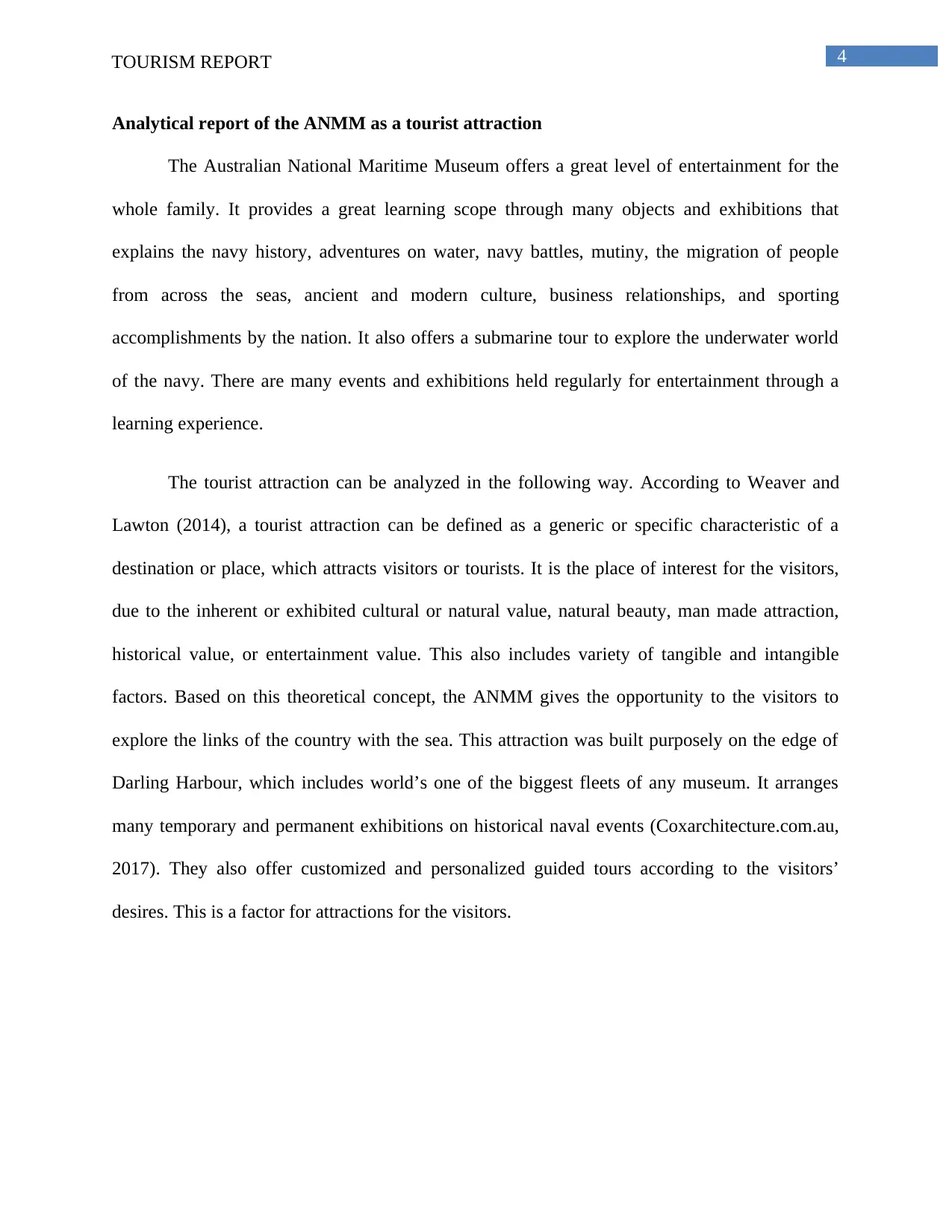
4TOURISM REPORT
Analytical report of the ANMM as a tourist attraction
The Australian National Maritime Museum offers a great level of entertainment for the
whole family. It provides a great learning scope through many objects and exhibitions that
explains the navy history, adventures on water, navy battles, mutiny, the migration of people
from across the seas, ancient and modern culture, business relationships, and sporting
accomplishments by the nation. It also offers a submarine tour to explore the underwater world
of the navy. There are many events and exhibitions held regularly for entertainment through a
learning experience.
The tourist attraction can be analyzed in the following way. According to Weaver and
Lawton (2014), a tourist attraction can be defined as a generic or specific characteristic of a
destination or place, which attracts visitors or tourists. It is the place of interest for the visitors,
due to the inherent or exhibited cultural or natural value, natural beauty, man made attraction,
historical value, or entertainment value. This also includes variety of tangible and intangible
factors. Based on this theoretical concept, the ANMM gives the opportunity to the visitors to
explore the links of the country with the sea. This attraction was built purposely on the edge of
Darling Harbour, which includes world’s one of the biggest fleets of any museum. It arranges
many temporary and permanent exhibitions on historical naval events (Coxarchitecture.com.au,
2017). They also offer customized and personalized guided tours according to the visitors’
desires. This is a factor for attractions for the visitors.
Analytical report of the ANMM as a tourist attraction
The Australian National Maritime Museum offers a great level of entertainment for the
whole family. It provides a great learning scope through many objects and exhibitions that
explains the navy history, adventures on water, navy battles, mutiny, the migration of people
from across the seas, ancient and modern culture, business relationships, and sporting
accomplishments by the nation. It also offers a submarine tour to explore the underwater world
of the navy. There are many events and exhibitions held regularly for entertainment through a
learning experience.
The tourist attraction can be analyzed in the following way. According to Weaver and
Lawton (2014), a tourist attraction can be defined as a generic or specific characteristic of a
destination or place, which attracts visitors or tourists. It is the place of interest for the visitors,
due to the inherent or exhibited cultural or natural value, natural beauty, man made attraction,
historical value, or entertainment value. This also includes variety of tangible and intangible
factors. Based on this theoretical concept, the ANMM gives the opportunity to the visitors to
explore the links of the country with the sea. This attraction was built purposely on the edge of
Darling Harbour, which includes world’s one of the biggest fleets of any museum. It arranges
many temporary and permanent exhibitions on historical naval events (Coxarchitecture.com.au,
2017). They also offer customized and personalized guided tours according to the visitors’
desires. This is a factor for attractions for the visitors.
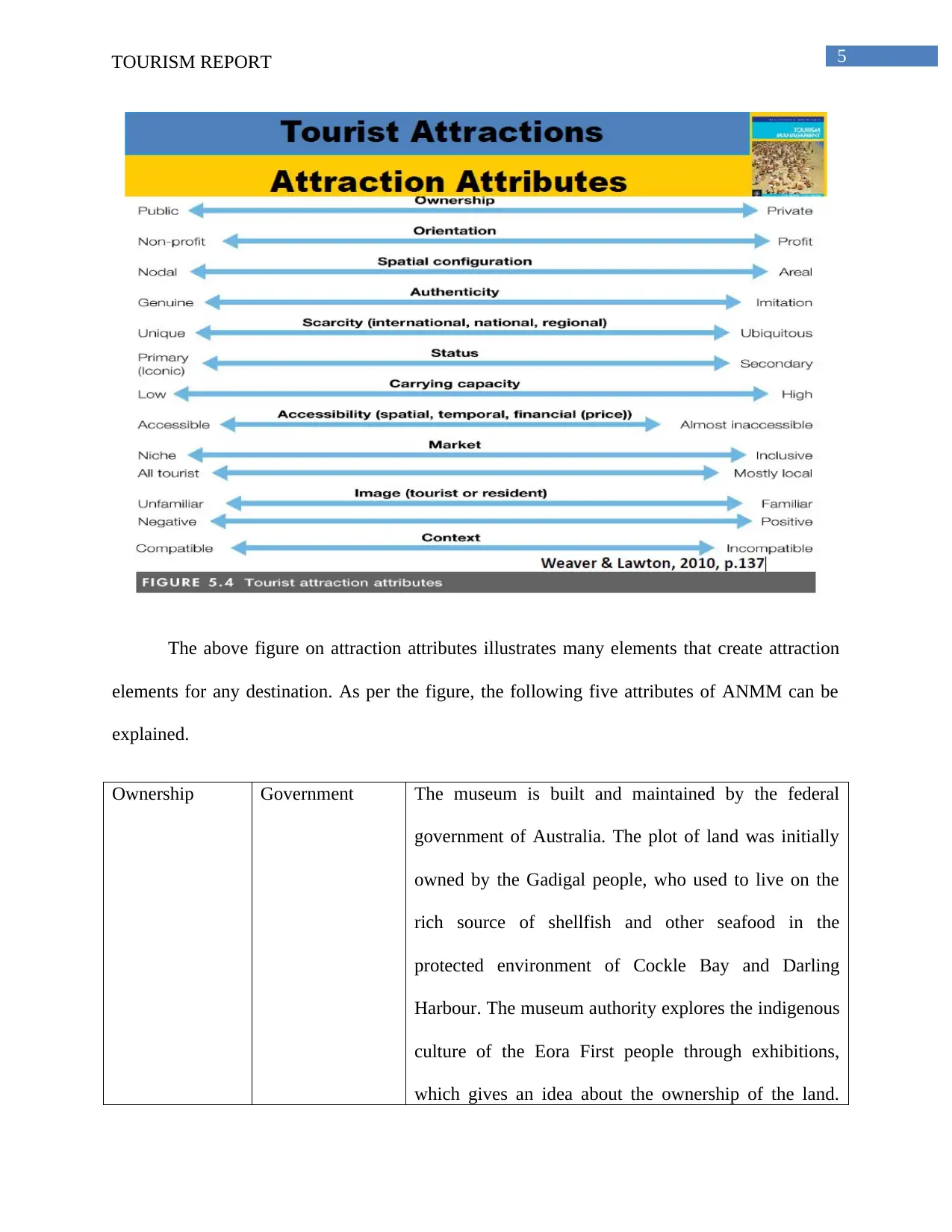
5TOURISM REPORT
The above figure on attraction attributes illustrates many elements that create attraction
elements for any destination. As per the figure, the following five attributes of ANMM can be
explained.
Ownership Government The museum is built and maintained by the federal
government of Australia. The plot of land was initially
owned by the Gadigal people, who used to live on the
rich source of shellfish and other seafood in the
protected environment of Cockle Bay and Darling
Harbour. The museum authority explores the indigenous
culture of the Eora First people through exhibitions,
which gives an idea about the ownership of the land.
The above figure on attraction attributes illustrates many elements that create attraction
elements for any destination. As per the figure, the following five attributes of ANMM can be
explained.
Ownership Government The museum is built and maintained by the federal
government of Australia. The plot of land was initially
owned by the Gadigal people, who used to live on the
rich source of shellfish and other seafood in the
protected environment of Cockle Bay and Darling
Harbour. The museum authority explores the indigenous
culture of the Eora First people through exhibitions,
which gives an idea about the ownership of the land.
⊘ This is a preview!⊘
Do you want full access?
Subscribe today to unlock all pages.

Trusted by 1+ million students worldwide
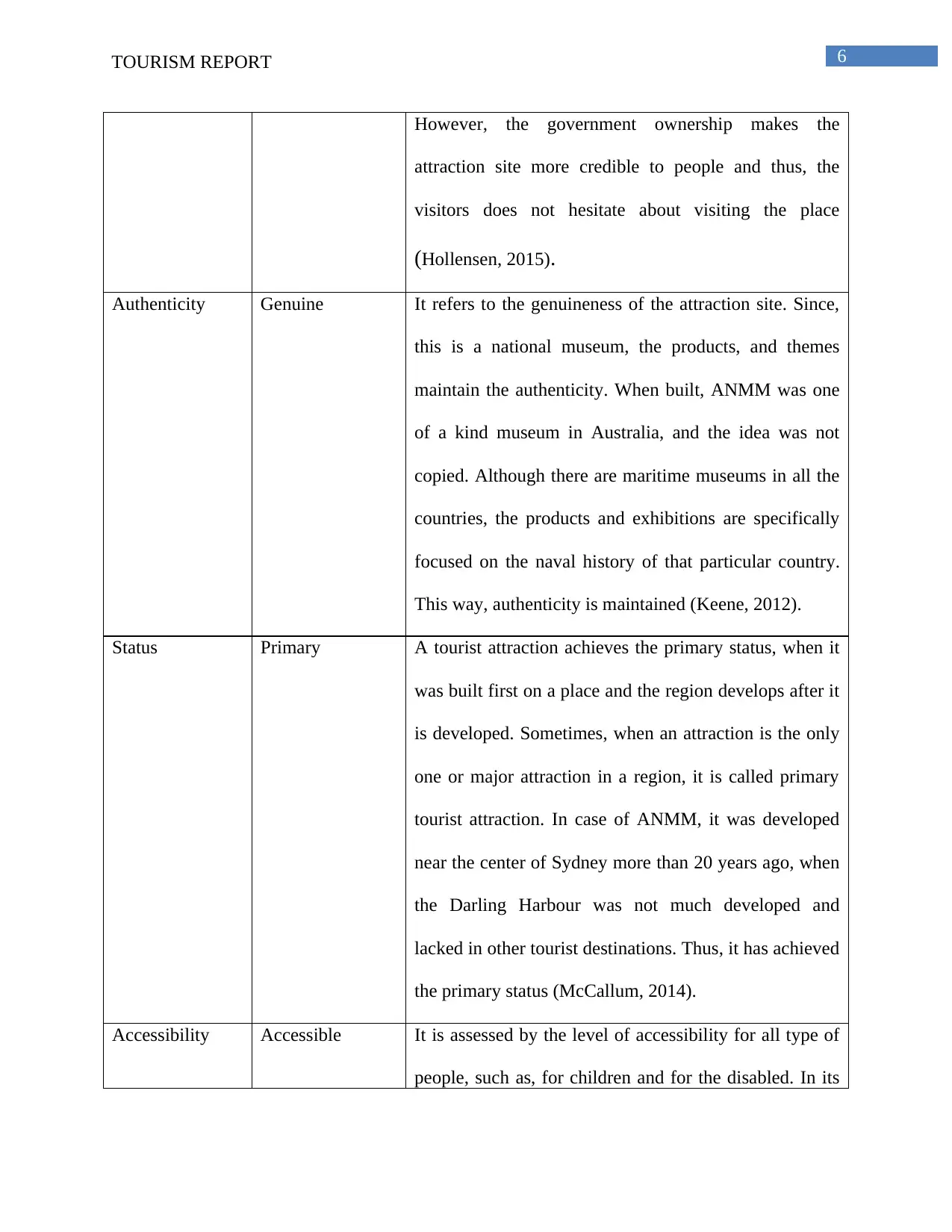
6TOURISM REPORT
However, the government ownership makes the
attraction site more credible to people and thus, the
visitors does not hesitate about visiting the place
(Hollensen, 2015).
Authenticity Genuine It refers to the genuineness of the attraction site. Since,
this is a national museum, the products, and themes
maintain the authenticity. When built, ANMM was one
of a kind museum in Australia, and the idea was not
copied. Although there are maritime museums in all the
countries, the products and exhibitions are specifically
focused on the naval history of that particular country.
This way, authenticity is maintained (Keene, 2012).
Status Primary A tourist attraction achieves the primary status, when it
was built first on a place and the region develops after it
is developed. Sometimes, when an attraction is the only
one or major attraction in a region, it is called primary
tourist attraction. In case of ANMM, it was developed
near the center of Sydney more than 20 years ago, when
the Darling Harbour was not much developed and
lacked in other tourist destinations. Thus, it has achieved
the primary status (McCallum, 2014).
Accessibility Accessible It is assessed by the level of accessibility for all type of
people, such as, for children and for the disabled. In its
However, the government ownership makes the
attraction site more credible to people and thus, the
visitors does not hesitate about visiting the place
(Hollensen, 2015).
Authenticity Genuine It refers to the genuineness of the attraction site. Since,
this is a national museum, the products, and themes
maintain the authenticity. When built, ANMM was one
of a kind museum in Australia, and the idea was not
copied. Although there are maritime museums in all the
countries, the products and exhibitions are specifically
focused on the naval history of that particular country.
This way, authenticity is maintained (Keene, 2012).
Status Primary A tourist attraction achieves the primary status, when it
was built first on a place and the region develops after it
is developed. Sometimes, when an attraction is the only
one or major attraction in a region, it is called primary
tourist attraction. In case of ANMM, it was developed
near the center of Sydney more than 20 years ago, when
the Darling Harbour was not much developed and
lacked in other tourist destinations. Thus, it has achieved
the primary status (McCallum, 2014).
Accessibility Accessible It is assessed by the level of accessibility for all type of
people, such as, for children and for the disabled. In its
Paraphrase This Document
Need a fresh take? Get an instant paraphrase of this document with our AI Paraphraser
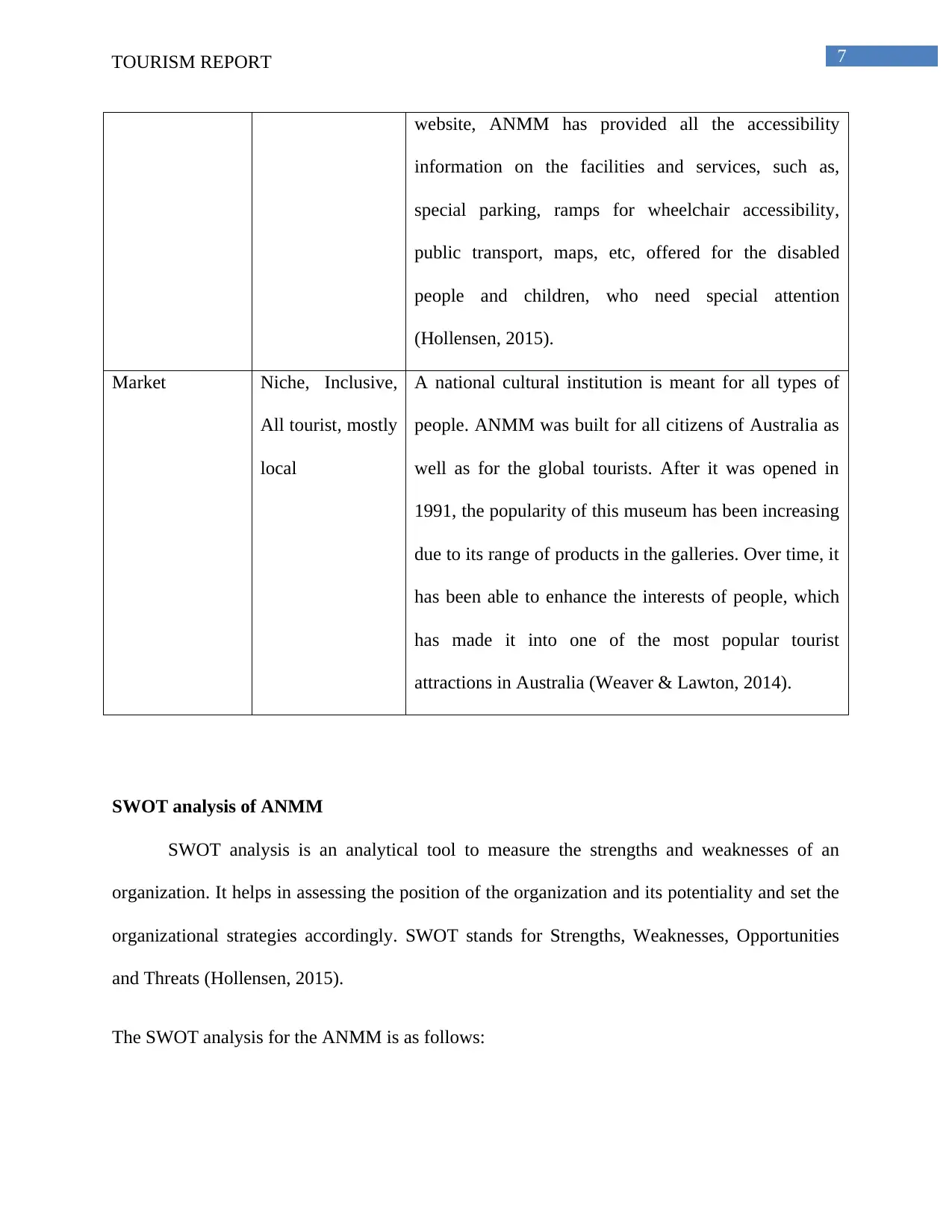
7TOURISM REPORT
website, ANMM has provided all the accessibility
information on the facilities and services, such as,
special parking, ramps for wheelchair accessibility,
public transport, maps, etc, offered for the disabled
people and children, who need special attention
(Hollensen, 2015).
Market Niche, Inclusive,
All tourist, mostly
local
A national cultural institution is meant for all types of
people. ANMM was built for all citizens of Australia as
well as for the global tourists. After it was opened in
1991, the popularity of this museum has been increasing
due to its range of products in the galleries. Over time, it
has been able to enhance the interests of people, which
has made it into one of the most popular tourist
attractions in Australia (Weaver & Lawton, 2014).
SWOT analysis of ANMM
SWOT analysis is an analytical tool to measure the strengths and weaknesses of an
organization. It helps in assessing the position of the organization and its potentiality and set the
organizational strategies accordingly. SWOT stands for Strengths, Weaknesses, Opportunities
and Threats (Hollensen, 2015).
The SWOT analysis for the ANMM is as follows:
website, ANMM has provided all the accessibility
information on the facilities and services, such as,
special parking, ramps for wheelchair accessibility,
public transport, maps, etc, offered for the disabled
people and children, who need special attention
(Hollensen, 2015).
Market Niche, Inclusive,
All tourist, mostly
local
A national cultural institution is meant for all types of
people. ANMM was built for all citizens of Australia as
well as for the global tourists. After it was opened in
1991, the popularity of this museum has been increasing
due to its range of products in the galleries. Over time, it
has been able to enhance the interests of people, which
has made it into one of the most popular tourist
attractions in Australia (Weaver & Lawton, 2014).
SWOT analysis of ANMM
SWOT analysis is an analytical tool to measure the strengths and weaknesses of an
organization. It helps in assessing the position of the organization and its potentiality and set the
organizational strategies accordingly. SWOT stands for Strengths, Weaknesses, Opportunities
and Threats (Hollensen, 2015).
The SWOT analysis for the ANMM is as follows:
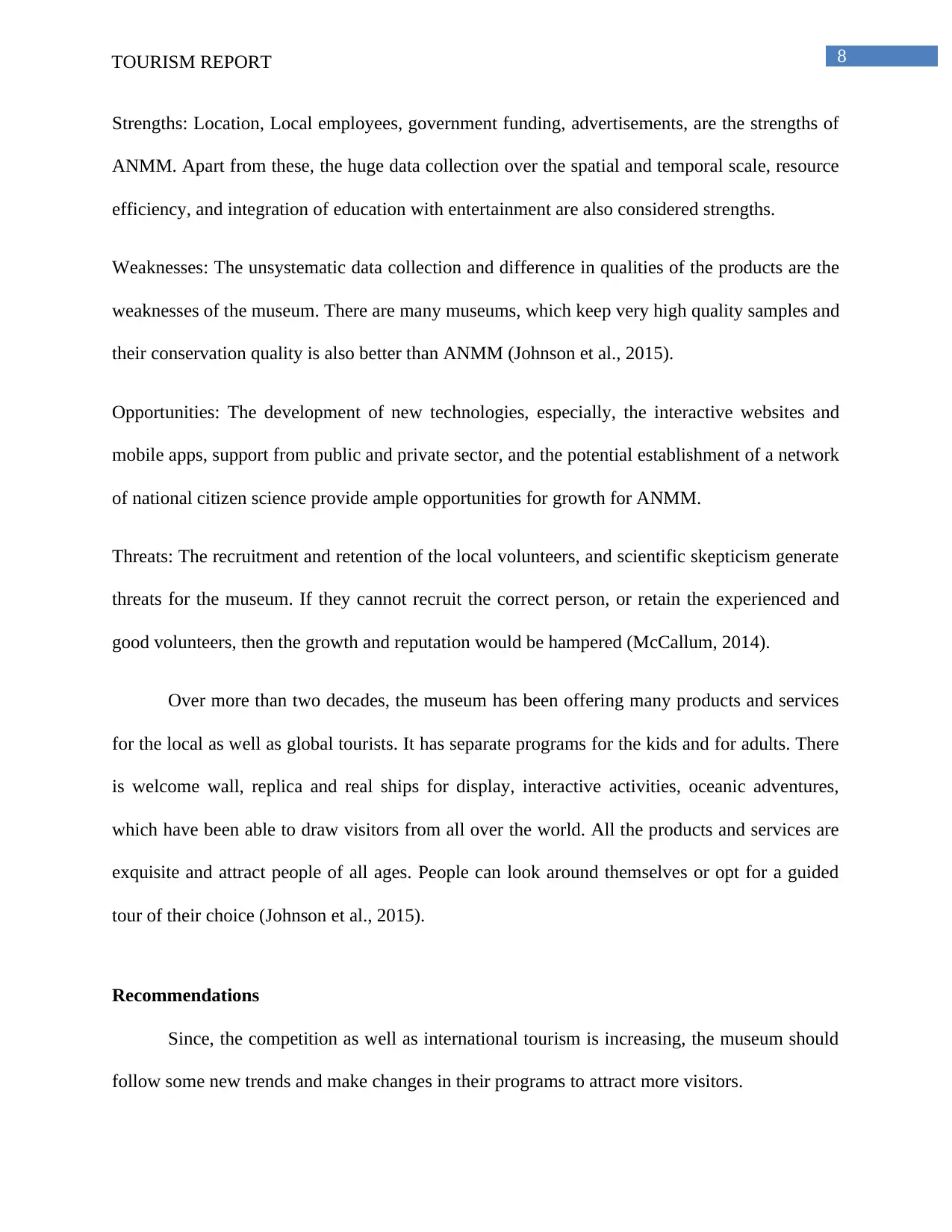
8TOURISM REPORT
Strengths: Location, Local employees, government funding, advertisements, are the strengths of
ANMM. Apart from these, the huge data collection over the spatial and temporal scale, resource
efficiency, and integration of education with entertainment are also considered strengths.
Weaknesses: The unsystematic data collection and difference in qualities of the products are the
weaknesses of the museum. There are many museums, which keep very high quality samples and
their conservation quality is also better than ANMM (Johnson et al., 2015).
Opportunities: The development of new technologies, especially, the interactive websites and
mobile apps, support from public and private sector, and the potential establishment of a network
of national citizen science provide ample opportunities for growth for ANMM.
Threats: The recruitment and retention of the local volunteers, and scientific skepticism generate
threats for the museum. If they cannot recruit the correct person, or retain the experienced and
good volunteers, then the growth and reputation would be hampered (McCallum, 2014).
Over more than two decades, the museum has been offering many products and services
for the local as well as global tourists. It has separate programs for the kids and for adults. There
is welcome wall, replica and real ships for display, interactive activities, oceanic adventures,
which have been able to draw visitors from all over the world. All the products and services are
exquisite and attract people of all ages. People can look around themselves or opt for a guided
tour of their choice (Johnson et al., 2015).
Recommendations
Since, the competition as well as international tourism is increasing, the museum should
follow some new trends and make changes in their programs to attract more visitors.
Strengths: Location, Local employees, government funding, advertisements, are the strengths of
ANMM. Apart from these, the huge data collection over the spatial and temporal scale, resource
efficiency, and integration of education with entertainment are also considered strengths.
Weaknesses: The unsystematic data collection and difference in qualities of the products are the
weaknesses of the museum. There are many museums, which keep very high quality samples and
their conservation quality is also better than ANMM (Johnson et al., 2015).
Opportunities: The development of new technologies, especially, the interactive websites and
mobile apps, support from public and private sector, and the potential establishment of a network
of national citizen science provide ample opportunities for growth for ANMM.
Threats: The recruitment and retention of the local volunteers, and scientific skepticism generate
threats for the museum. If they cannot recruit the correct person, or retain the experienced and
good volunteers, then the growth and reputation would be hampered (McCallum, 2014).
Over more than two decades, the museum has been offering many products and services
for the local as well as global tourists. It has separate programs for the kids and for adults. There
is welcome wall, replica and real ships for display, interactive activities, oceanic adventures,
which have been able to draw visitors from all over the world. All the products and services are
exquisite and attract people of all ages. People can look around themselves or opt for a guided
tour of their choice (Johnson et al., 2015).
Recommendations
Since, the competition as well as international tourism is increasing, the museum should
follow some new trends and make changes in their programs to attract more visitors.
⊘ This is a preview!⊘
Do you want full access?
Subscribe today to unlock all pages.

Trusted by 1+ million students worldwide
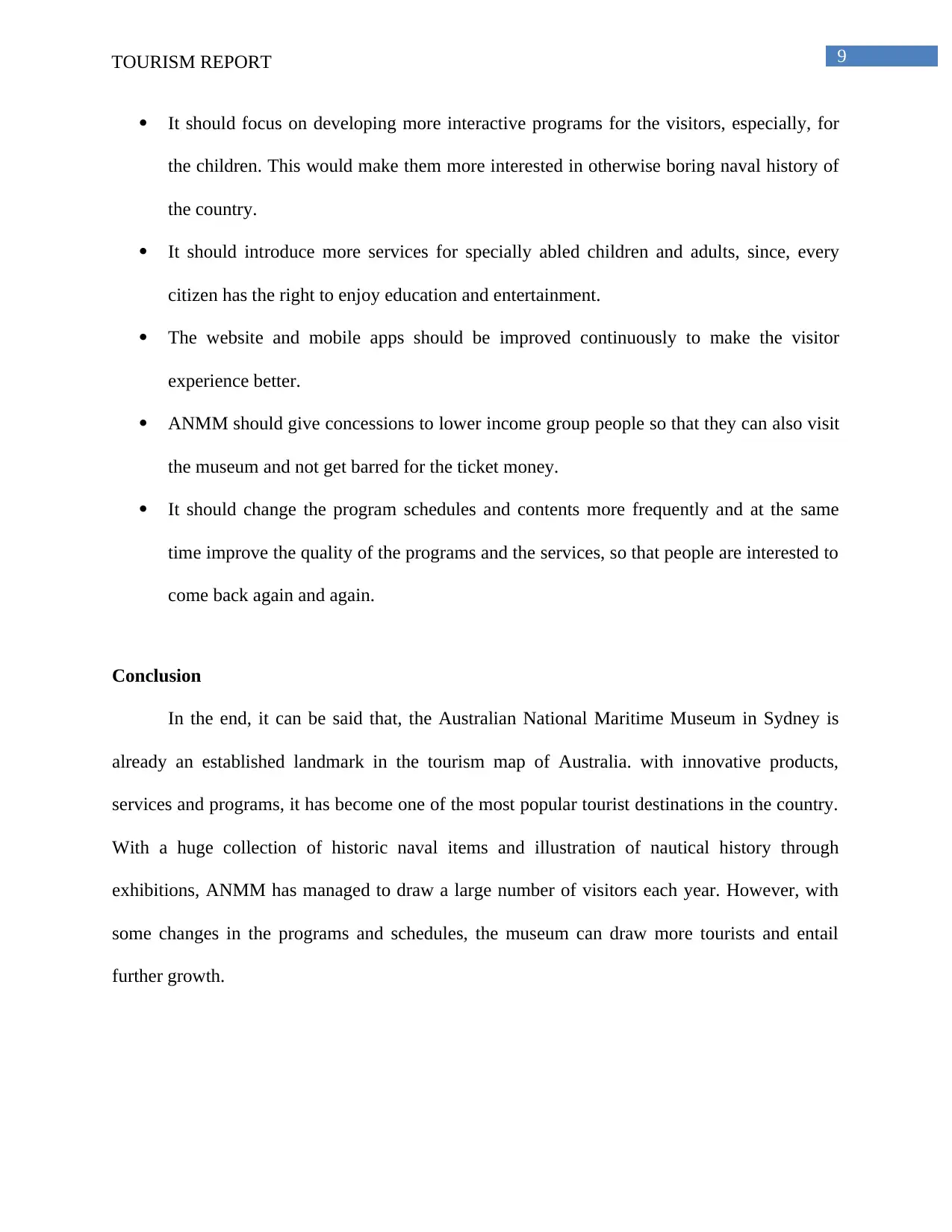
9TOURISM REPORT
It should focus on developing more interactive programs for the visitors, especially, for
the children. This would make them more interested in otherwise boring naval history of
the country.
It should introduce more services for specially abled children and adults, since, every
citizen has the right to enjoy education and entertainment.
The website and mobile apps should be improved continuously to make the visitor
experience better.
ANMM should give concessions to lower income group people so that they can also visit
the museum and not get barred for the ticket money.
It should change the program schedules and contents more frequently and at the same
time improve the quality of the programs and the services, so that people are interested to
come back again and again.
Conclusion
In the end, it can be said that, the Australian National Maritime Museum in Sydney is
already an established landmark in the tourism map of Australia. with innovative products,
services and programs, it has become one of the most popular tourist destinations in the country.
With a huge collection of historic naval items and illustration of nautical history through
exhibitions, ANMM has managed to draw a large number of visitors each year. However, with
some changes in the programs and schedules, the museum can draw more tourists and entail
further growth.
It should focus on developing more interactive programs for the visitors, especially, for
the children. This would make them more interested in otherwise boring naval history of
the country.
It should introduce more services for specially abled children and adults, since, every
citizen has the right to enjoy education and entertainment.
The website and mobile apps should be improved continuously to make the visitor
experience better.
ANMM should give concessions to lower income group people so that they can also visit
the museum and not get barred for the ticket money.
It should change the program schedules and contents more frequently and at the same
time improve the quality of the programs and the services, so that people are interested to
come back again and again.
Conclusion
In the end, it can be said that, the Australian National Maritime Museum in Sydney is
already an established landmark in the tourism map of Australia. with innovative products,
services and programs, it has become one of the most popular tourist destinations in the country.
With a huge collection of historic naval items and illustration of nautical history through
exhibitions, ANMM has managed to draw a large number of visitors each year. However, with
some changes in the programs and schedules, the museum can draw more tourists and entail
further growth.
Paraphrase This Document
Need a fresh take? Get an instant paraphrase of this document with our AI Paraphraser
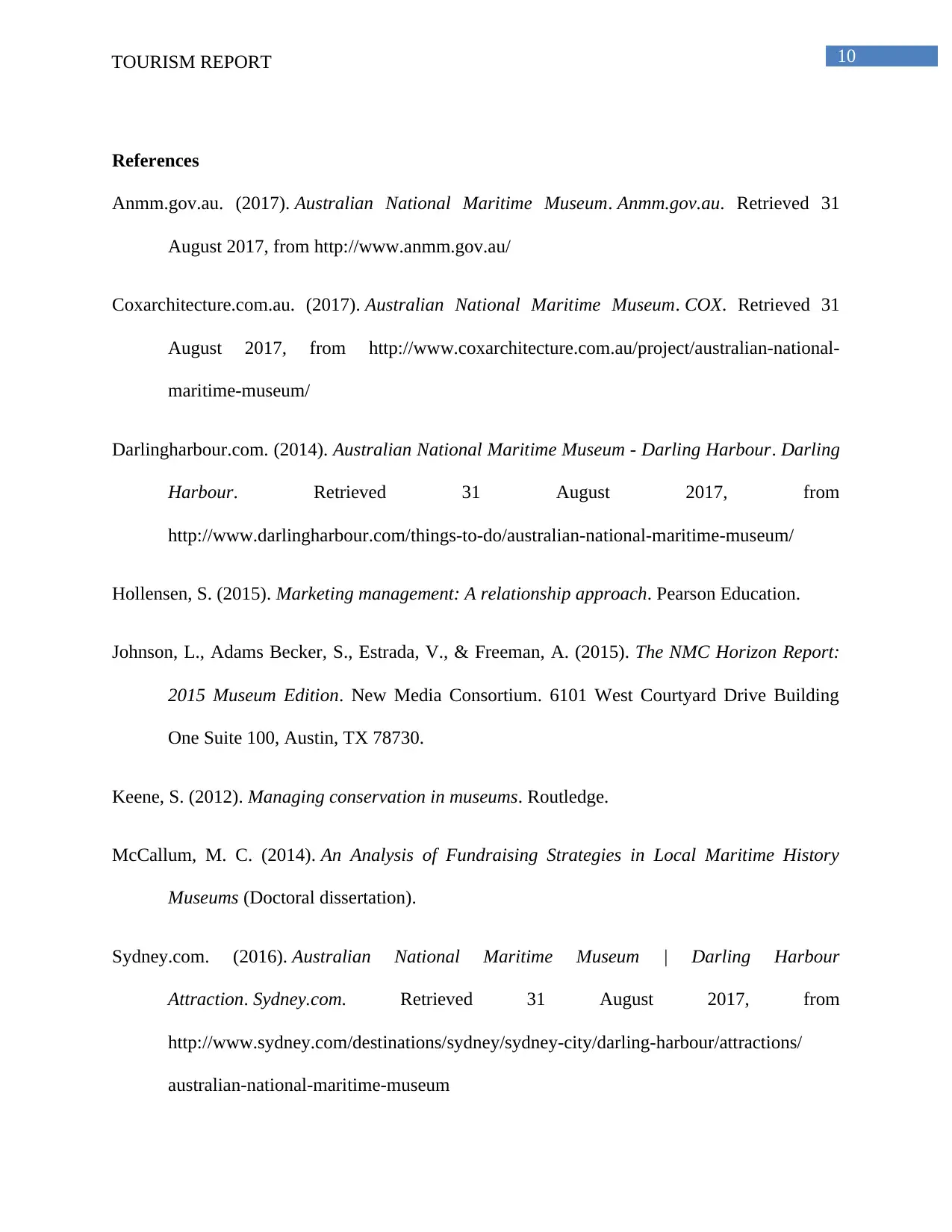
10TOURISM REPORT
References
Anmm.gov.au. (2017). Australian National Maritime Museum. Anmm.gov.au. Retrieved 31
August 2017, from http://www.anmm.gov.au/
Coxarchitecture.com.au. (2017). Australian National Maritime Museum. COX. Retrieved 31
August 2017, from http://www.coxarchitecture.com.au/project/australian-national-
maritime-museum/
Darlingharbour.com. (2014). Australian National Maritime Museum - Darling Harbour. Darling
Harbour. Retrieved 31 August 2017, from
http://www.darlingharbour.com/things-to-do/australian-national-maritime-museum/
Hollensen, S. (2015). Marketing management: A relationship approach. Pearson Education.
Johnson, L., Adams Becker, S., Estrada, V., & Freeman, A. (2015). The NMC Horizon Report:
2015 Museum Edition. New Media Consortium. 6101 West Courtyard Drive Building
One Suite 100, Austin, TX 78730.
Keene, S. (2012). Managing conservation in museums. Routledge.
McCallum, M. C. (2014). An Analysis of Fundraising Strategies in Local Maritime History
Museums (Doctoral dissertation).
Sydney.com. (2016). Australian National Maritime Museum | Darling Harbour
Attraction. Sydney.com. Retrieved 31 August 2017, from
http://www.sydney.com/destinations/sydney/sydney-city/darling-harbour/attractions/
australian-national-maritime-museum
References
Anmm.gov.au. (2017). Australian National Maritime Museum. Anmm.gov.au. Retrieved 31
August 2017, from http://www.anmm.gov.au/
Coxarchitecture.com.au. (2017). Australian National Maritime Museum. COX. Retrieved 31
August 2017, from http://www.coxarchitecture.com.au/project/australian-national-
maritime-museum/
Darlingharbour.com. (2014). Australian National Maritime Museum - Darling Harbour. Darling
Harbour. Retrieved 31 August 2017, from
http://www.darlingharbour.com/things-to-do/australian-national-maritime-museum/
Hollensen, S. (2015). Marketing management: A relationship approach. Pearson Education.
Johnson, L., Adams Becker, S., Estrada, V., & Freeman, A. (2015). The NMC Horizon Report:
2015 Museum Edition. New Media Consortium. 6101 West Courtyard Drive Building
One Suite 100, Austin, TX 78730.
Keene, S. (2012). Managing conservation in museums. Routledge.
McCallum, M. C. (2014). An Analysis of Fundraising Strategies in Local Maritime History
Museums (Doctoral dissertation).
Sydney.com. (2016). Australian National Maritime Museum | Darling Harbour
Attraction. Sydney.com. Retrieved 31 August 2017, from
http://www.sydney.com/destinations/sydney/sydney-city/darling-harbour/attractions/
australian-national-maritime-museum
1 out of 11
Related Documents
Your All-in-One AI-Powered Toolkit for Academic Success.
+13062052269
info@desklib.com
Available 24*7 on WhatsApp / Email
![[object Object]](/_next/static/media/star-bottom.7253800d.svg)
Unlock your academic potential
Copyright © 2020–2025 A2Z Services. All Rights Reserved. Developed and managed by ZUCOL.





